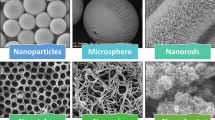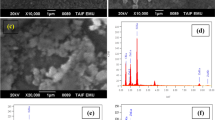Abstract
A facile hierarchical microstructured ZnO thin films consisting of microspheres and nanorods were deposited on zinc oxide–titanium oxide (ZnO–TiO2) seeded FTO substrate by applying a two-step chemical techniques. At first, ZnO microsphere was electrochemically deposited on ZnO–TiO2 seeded FTO substrate by varying the deposition potentials in the range of − 1.1 to − 1.3 V. Followed by, the nanorods were hydrothermally grown on the optimized ZnO microsphere (ZnO electrodeposited at − 1.3 V). SEM displays the ZnO microsphere and nanorod for films deposited by electrodeposition of − 1.3 and hydrothermal technique, respectively. The suppression of ZnO growth along the (0001) orientation is noticed due to electrostatic absorption of citrate ions. TEM images confirm the hexagonal structure of microstructures and nanorods oriented along the lateral and c-axis growth direction, respectively. The appearance of high-intensity XRD peaks, Raman E2 (high) mode and UV emission confirms the hierarchical structure possessing a higher crystalline nature with lesser atomic defects. The hierarchical structure has high dye absorption, light absorption and scattering ability. The efficiency (η) of dye sensitized solar cells (DSSCs) consisting microsphere and hierarchical structures is found to be 3.13 and 4.64%, respectively. The DSSC consisting of hierarchical structure has the higher charge transfer recombination resistance (Rrec) and electron lifetime (τr) than other DSSC.










Similar content being viewed by others
References
Chung J, Myoung J, Oh J, Lim S (2010) Synthesis of a ZnS shell on the ZnO nanowire and its effect on the nanowire based dye-sensitized solar cells. J Phys Chem C 114:21360–21365
Makhal A, Sarkar S, Bora T, Baruah S, Dutta J, Raychaudhuri AK, Kumar Pal S (2010) Role of resonance energy transfer in light harvesting of zinc oxide based dye-sensitized solar cells. J Phys Chem C 114:10390–10395
Li Y, Wang Y, Chen C, Pang A, Wei M (2012) Incorporating Zn2SnO4 quantum dots and aggregates for enhanced performance in dye sensitized ZnO solar cells. Chem Eur J 18:11716–11722
Schlur L, Carton A, Leveque P, Guillon D, Pourroy G (2013) Optimization of a new ZnO nanorods hydrothermal synthesis method for solid state dye sensitized solar cells applications. J Phys Chem C 117:2993–3001
Marimuthu T, Anandhan N, Thangamuthu R (2018) Electrochemical synthesis of one-dimensional ZnO nanostructures on ZnO seed layer for DSSC applications. Appl Surf Sci 428:385–394
Zhu S, Shan L, Chen X, He L, Chen J, Jiang M, Xie X, Zhou Z (2013) Hierarchical ZnO architectures consisting of nanorods and nanosheets prepared via a solution route for photovoltaic enhancement in dye-sensitized solar cells. RSC Adv 3:2910–2916
Xu C, Gao D (2012) Two-stage hydrothermal growth of long ZnO nanowire for efficient TiO2 nanotube-based dye-sensitized solar cells. J Phys Chem C 116:7236–7241
Alberti A, Pellegrino G, Condorelli GG, Bongiorno C, Morita S, La Magna V, Miyasaka T (2014) Efficiency enhancement in ZnO: Al based dye-sensitized solar cells structured with sputtered TiO2 blocking layers. J Phys Chem C 118:6576–6585
Chen H-Y, Kuang D-B, Su C-Y (2012) Hierarchically micro/nanostructured photoanode materials for dye sensitized solar cells. J Mater Chem 22:15475–15489
Hosni M, Kusumawati Y, Farhat S, Jouini N, Pauporte Th (2014) Effect of oxide nanoparticle size and shape on electronic structure, charge transport, and recombination in dye-sensitized solar cell photoelectrodes. J Phys Chem C 118:16791–16798
Marimuthu T, Anandhan N (2017) Growth and characterization of ZnO nanostructure on TiO2–ZnO films as a light scattering layer for dye sensitized solar cells. Mater Res Bull 95:616–624
Chou TP, Zhang Q, Fryxell GE, Cao G (2007) Hierarchically structured ZnO film for dye-sensitized solar cells with enhanced energy conversion efficiency. Adv Mater 19:2588–2592
Agrwal DC, Chauhan RS, Kumar A, Kabiraj D, Singh F, Khan SA, Avasthi DK, Pivin JC, Kumar M, Ghatak J, Satyam PV (2006) Synthesis and characterization of ZnO thin film grown by electron beam evaporation. J Appl Phys 99:123105–123110
Marimuthu T, Anandhan N, Mahalingam T, Thangamuthu R, Mummoorthi M (2015) Effect of P. Murex on the properties of spin coated ZnO thin films for dye sensitized solar cell applications. J Mater Sci Mater Electron 26:7577–7587
Raja M, Muthukumarasamy N, Velauthapillai D, Balasundraprabhu R, Agilan S, Senthil FS (2014) Studies on bundle like ZnO nanorods for solar cell applications. Sol Energy 106:129–135
Marimuthu T, Anandhan N, Thangamuthu R, Mummoorthi M, Rajendran S, Ravi G (2015) Surfactant mediated one and two dimensional ZnO nanostructured thin films for dye sensitized solar cell application. Mater Res Express 2:015502–015560
Marimuthu T, Anandhan N, Thangamuthu R, Surya S (2017) Facile growth of ZnO nanowire arrays and nanoneedle arrays with flower structure on ZnO–TiO2 seed layer for DSSC applications. J Alloys Compd 693:1011–1019
Marimuthu T, Anandhan N, Thangamuthu R, Mummoorthi M, Ravi G (2016) Synthesis of ZnO nanowire array on ZnO–TiO2 seed layer for dye sensitized solar cell applications. J Alloys Compd 677:211–218
Lin L, Peng X, Chen S, Zhang B, Feng Y (2015) Preparation of diverse flower-like ZnO nanoaggregates for dye-sensitized solar cells. RSC Adv 5:25215–25221
Zhu S, Tian X, Chen J, Shan L, Xu X, Zhou Z (2014) A facile approach to construct multiple structured ZnO crystals by trisodium citrate assisted hydrothermal growth toward performance enhanced of dye sensitized solar cells. J Phys Chem C 118:16401–16407
Shinagawa T, Izaki M (2014) Morphological evolution of ZnO nanorod arrays induced by a pH buffering effect during electrochemical deposition. RSC Adv 4:30999–31002
Zoolfakar SM, Ab Kadir R, Abdul Rani R, Balendhran S, Liu X, Kats E, Bhargava S, Bhaskaran M, Sriram S, Zhuiykov S, O’Mullane AP, Kalanta-zadeh K (2013) Engineering electrodeposited ZnO films and their memristive switching performance. Phys Chem Chem Phys 15:10376–10384
Palumbo M, Lutz T, Giusca CE, Shiozawa H, Stolojan V, Cox DC, Wilson RM, Henley SJ, Ravi S, Silva P (2009) From stems to roses: shape-controlled synthesis of zinc oxide crystals. Cryst Growth Des 9:3432–3437
Panigrahy B, Aslam M, Bahadur D (2010) Aqueous synthesis of Mn- and Co-doped ZnO nanorods. J Phys Chem C 114:11758–11763
Inguanta R, Garlisi C, Spano T, Plazza S, Sunseri C (2013) Growth and photoelectrochemical behaviour of electrodeposited ZnO thin films for solar cells. J Appl Electrochem 43:199–208
Kim MS, Yim KG, Lee D-Y, Kim JS, Kim JS, Son J-S, Leem J-Y (2011) Effects of cooling rate and post-heat treatment on properties of ZnO thin films deposited by sol–gel method. Appl Surf Sci 257:9019–9023
Li G-R, Dawa C-R, Bu Q, Lu X-H, Ke Z-H, Hong H-E, Zheng F-L, Yao C-Z, Liu G-K, Tong Y-X (2007) Electrochemical self assembly of ZnO nanoporous structures. J Phys Chem C 111:1919–1923
Park SK, Park JH, Ko KY, Yoon S, Chu KS, Kim W, Do YR (2009) Hydrothermal–electrochemical synthesis of ZnO nanorods. Cryst Growth Des 9:3615–3620
Sheini FJ, More MA, Jadkar SR, Patil KR, Pillai VK, Joag DS (2010) Observation of photoconductivity in Sn-doped ZnO nanowires and their photoenhanced field emission behavior. J Phys C hem C 114:3843–3849
Chen H, Ding J, Guo W, Chen G, Ma S (2013) Blue-green emission mechanism and spectral shift of Al-doped ZnO films related to defect levels. RSC Adv 3:12327–12333
Zhang Q, Chou TP, Russo B, Jenekhe SA, Cao G (2008) Aggregation of ZnO nanocrystallites for high conversion efficiency in dye-sensitized solar cells. Angew Chem 120:2436–2440
Yoshida T, Terada K, Schlettwein D, Oekermann T, Sugiura T, Minoura H (2000) Electrochemical self-assembly of nanoporous ZnO/eosin Y thin films and their sensitized photoelectrochemical performance. Adv Mater 12:1214–1217
Kim KS, Song H, Nam SH, Kim S-M, Jeong H, Kim WB, Jung GY (2012) Fabrication of an efficient light scattering functionalized photoanode using periodically aligned ZnO hemisphere crystal for dye sensitized solar cells. Adv Mater 24:792–798
Shin SS, Kim DW, Hwang D, Suk JH, Oh LS, Han BS, Kim DH, Kim JS, Kim D, Kim JY, Hong KS (2014) Controlled interfacial electron dynamics in highly efficient Zn2SnO4 based dye sensitized solar cells. Chemsuschem 7:501–509
Wang JX, Wu CML, Cheung WS, Luo LB, He ZB, Yuan GD, Zhang WJ (2010) Synthesis of hierarchical porous ZnO dislike nanostructures for improved photovoltaic properties of dye-sensitized solar cells. J Phys Chem C 114:13157–13161
Shi Y, Wang K, Du Y, Zhang H, Gu J, Zhu C, Wang L, Guo W, Hagfeldt A, Wang N, Ma T (2013) Solid-state synthesis of ZnO nanostructures for quasi-solid dye-sensitized solar cells with high efficiencies up to 6.46. Adv Mater 25:4413–4419
Musselman KP, Marin A, Wisnet A, Scheu C, MacManus-Driscoll JL, Schmidt-Mende L (2012) A novel buffering technique for aqueous processing of zinc oxide nanostructures and interfaces and corresponding improvement of electrodeposited ZnO–Cu2O photovoltaics. Adv Funct Mater 21:573–582
Zhao C, Child D, Hu Y, Robertson N, Gibson D, Wang SC, Fu YQ (2014) Low temperature growth of hybrid ZnO/TiO2 nanosculptured foxtail-structures for dye-sensitized solar cells. RSC Adv 4:61153–61159
Acknowledgements
Author T.Marimuthu [Student ID: 201213-BSR-10183-2] wishes to thank University Grants Commission (UGC), New Delhi, for providing the financial support through UGC-BSR scheme to characterize the deposited micro- and nanostructures.
Author information
Authors and Affiliations
Corresponding author
Ethics declarations
Conflict of interest
The authors declared that they have no conflict of interest.
Electronic supplementary material
Below is the link to the electronic supplementary material.
Rights and permissions
About this article
Cite this article
Marimuthu, T., Anandhan, N. & Thangamuthu, R. A facile electrochemical–hydrothermal synthesis and characterization of zinc oxide hierarchical structure for dye sensitized solar cell applications. J Mater Sci 53, 12441–12454 (2018). https://doi.org/10.1007/s10853-018-2524-9
Received:
Accepted:
Published:
Issue Date:
DOI: https://doi.org/10.1007/s10853-018-2524-9




